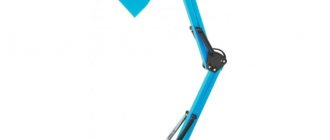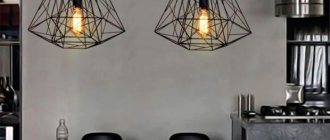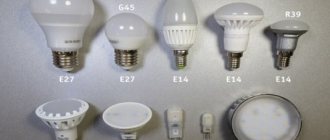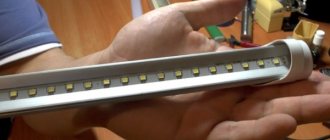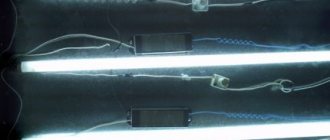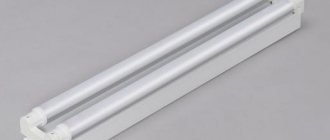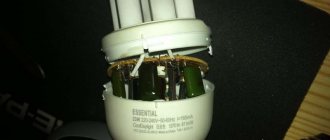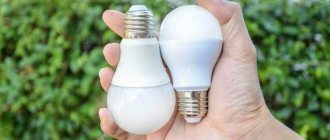Choosing a lamp
Having become a little familiar with the theory, it’s time to move on to practice – that is, to choosing a device.
Design, of course, is important - any detail in the room must correspond to the overall style of the interior, this also applies to lighting fixtures. Grandma's heavy lamp with the tasseled shade probably still works, but does it look as good in your room? Only if your entire decor is in Retro style, then this rarity has no price. In all other cases, it is better to choose something more modern and less bulky. There are three main considerations when purchasing:
- The lamp should be comfortable.
- He must perform his functions efficiently.
- The lamp should not be allowed to clutter the table.
Convenience
Modern lamps are suitable for both a regular desk and a computer desk. They have several useful parts to ensure this. For example, a tripod. It is mobile, and two simple devices can ensure this:
- flexible tube;
- rigid tripod.
A tube
Wires leading to the light source are inserted into a flexible tube. The tube can be:
- metal;
- plastic.
In appearance and structure it is similar to the one to which the shower head is attached, and it has similar functions, only in one case it correctly directs the flow of water, and in the other - light
When purchasing, you need to pay attention to how easily this part bends. If this can be done effortlessly, you can easily direct the light flow where you need it:
- in front of;
- up;
- to the side;
- down.
Tripod
This part consists of two parts. Both of them are rigid, and are fastened together by a rotating mechanism. If you need to change the direction of the light flow, you simply move the lamp. The tripod halves, fastened with a screw, change position relative to each other. The tripod is also connected to the lampshade via a role-playing mechanism. This allows you to change the direction of the light by slightly turning the hood.
Mobility
Since a modern lamp is equipped with a device that allows it to direct light to any place, it is not at all necessary to move it across the table in order to illuminate some other area. That is, it can and should be fixed, especially since this provides a lot of advantages. How is a table lamp attached to a table? In one of two ways:
- on clamps;
- on a clothespin.
In the first case, the lamp is installed on the edge of the tabletop using a clamp and screw. The screw is tightened, the lamp does not move until you decide to move it to another place. When you need it, you can unscrew the screw and remove the device without any additional equipment.
The second option is even simpler - the fastening works exactly the same as any other clothespin. To remove the lamp from the table, you just need to press the plate.
Mounting methods and lamp installation options
Let's look at how to attach a table lamp to a table. There are three main options:
- installation on the edge of the table cover using a clamp or clothespin;
- installation on a shelf located above the table;
- mounting on the wall near which the table is installed;
- simple installation of the lamp, which has its own support, on the table surface.
The first three methods require the presence of a clamp (clothespin) or a special platform for mounting to the wall with screws. The last option is a conventional design with its own stand. It is not strictly tied to a specific point and can be installed anywhere.
Installation is not difficult at all. The clamp c must be installed at the desired point on the edge of the table and securely screwed with the clamping screw located at the bottom. It must be taken into account that the force of the screw can exceed the strength of the clamp and destroy it, so you must act carefully and carefully. There are many models on the market from Southeast Asian countries, the manufacture of which uses low-quality materials. Excessive tightening of the clamp is contraindicated for them in principle.
Tips and rules for tabletop instruments
Before embarking on your plan, it is necessary to take into account some of the features of such lamps, because a lack of light will inevitably lead to deterioration of vision.
- If a table lamp is intended for work, when installing it, you need to remember with which hand the person writes. Otherwise, the shadow falling from the hand will create significant inconvenience.
- The minimum distance of the lamp from the table surface should be 350 mm, the maximum - 400 mm.
- When the lamp is adjacent to the monitor on the table, it should be above its top edge.
- It is not recommended to direct the light from the lamp onto the face.
These rules apply to all table lamps - both purchased and those made with your own hands.
A DIY table lamp is a good way to free your closet or cottage from unnecessary things. The low cost of such a thing is attractive, and the reward for the owners will be a unique design that purchased models cannot boast of, and the joy that invariably appears after a job successfully completed.
You can get some ideas from this popular video:
IKEA TERTIAL lamp - review
Hey everyone
Since my daughter will go to first grade this fall, now the issue of organizing a schoolgirl’s workplace is urgent for me: a desk, a chair and, of course, a lamp.
I read the reviews, looked through the forums and found a “good and inexpensive” lamp: of course, Ikea helped! The Tertial lamp fit the description perfectly. But, when using the desk, some problems arise that I have not read about anywhere. Therefore, I decided to fill this gap.
■Where to buy?
In countries where there is Ikea, this is not a problem. As a resident of Belarus, I had to use the services of intermediaries, since there are plenty of such companies in Gomel.
■ Price?
On the website the lamp costs 799 RUR. rubles With the services of intermediaries, the light bulb cost me 38 bel. rubles ($19)
■ Colors
The Tertial lamp is available (now) in three colors: black, white and yellow.
■ ASSEMBLY
The lamp is sold disassembled; assembling it is not particularly difficult. There are instructions.
Ikea table lamp
What the lamp is made of can be read on the label. Let me note that it was assembled by the same hardworking, ubiquitous Chinese)
■Instructions
*The lampshade is put on quite tightly, you will have to strain a little.
■ USE
As I wrote above, the lamp is intended for the desk of a future schoolgirl. Our desk has a solid tabletop; we installed it at a slight angle.
Therefore, I was looking for a lamp that has a clamp or clamp that is fixed to the tabletop.
Organization of a schoolchild's workplace
I believed that Tertial would completely satisfy my needs
But that was not the case: please note: everyone’s lamp is installed on straight tables. Who has a desk, the lamps are attached to a rising tabletop (or something nearby)
I didn’t pay attention to this - little things...
But in fact it turned out like this: the lamp is unstable on the inclined tabletop. Not even that: the clamp is screwed on tightly, but the tripod itself (rod) is simply inserted into the mount. It is not fixed in any way, it moves easily in all directions. When the lamp is installed on a straight tabletop, everything works as it should. If you screw it on at an angle, then under the influence of gravity, it follows the slope... There are 2 options: either somehow fix this rotation at the base or simply screw it onto a straight tabletop.
Since our desk is in front of the window, we will attach it to the window sill (for this we will still have to look for a block under the window sill). The photo is attached to the “draft”:
Therefore, I recommend that desk owners carefully consider where you will attach the lamp or take a clothespin with a bendable wire leg.
Despite this revealed minus, I am satisfied with the lamp - it is made well:
The lampshade was looking for exactly this shape: it directs light well to the desired area and the lamp does not blind the eyes.
When using an LED lamp, the lampshade does not heat up and changing the position of the lamp is easy. Fixed accurately.
Tertial ikea
Thanks to the high leg, it is not a problem to illuminate the entire 120 cm tabletop of the desk.
* This is how we installed the Tertial lamp. Don’t pay attention to the creative mess, the child often uses the table) And I haven’t bought the cover yet...
Ikea tertial lamp in yellow
Well, one last photo in the evening. The lamp illuminates well, the child is happy.
Belarusian solid wood furniture. A desk for a schoolgirl for only $110. Showing my first-grader's workplace!
I recommend the Tertial lamp. But think about where you will place it!
How to attach a table lamp to a table – Furniture Portal
This is especially important if there is little or no natural light. A modern table lamp will help you out a lot if it is positioned correctly and mounted well.
How to attach a lamp to a table? Now we will discuss this.
Two words about models
Table lamps are produced by many electrical equipment companies. The brands that are most loved by consumers are:
- Camelion;
- Odeon;
- Uniel;
- Lussol;
- Brilliant,
- Globo;
- Feron.
There are also products from other companies on sale. The price range and technical characteristics are very diverse, so the choice depends entirely on the needs of the individual user.
Similarities and differences
Before assembling a table lamp that is attached to the table, it is very useful to understand what kind of lamps there are for the workplace. Without exception, all table lamps are designed for local lighting. As for the differences, there are many more of them:
- type of lamps;
- power;
- mains voltage;
- fastening method;
- body material;
- lampshade design.
Choosing a lamp
Having become a little familiar with the theory, it’s time to move on to practice – that is, to choosing a device. Design, of course, is important - any detail in the room must correspond to the overall style of the interior, this also applies to lighting fixtures.
Grandma's heavy lamp with the tasseled shade probably still works, but does it look as good in your room? Only if your entire decor is in Retro style, then this rarity has no price.
In all other cases, it is better to choose something more modern and less bulky.
There are three main considerations when purchasing:
- The lamp should be comfortable.
- He must perform his functions efficiently.
- The lamp should not be allowed to clutter the table.
A tube
Wires leading to the light source are inserted into a flexible tube. The tube can be:
- metal;
- plastic.
In appearance and structure it is similar to the one to which the shower head is attached, and it has similar functions, only in one case it correctly directs the flow of water, and in the other - light
When purchasing, you need to pay attention to how easily this part bends. If this can be done effortlessly, you can easily direct the light flow where you need it:
- in front of;
- up;
- to the side;
- down.
Important! Don’t forget to also check how well you can fix this element in the desired position. The tube should not bend without your desire, solely under the weight of its own lampshade
Advantages of a fixed lamp
Regardless of how you prefer to attach the lamp to the table, a lamp with a mount has a number of advantages:
- it cannot be accidentally thrown onto the floor;
- the base takes up virtually no space on the table;
- the lamp does not lose mobility.
Setting up a desktop
Before you attach a desk lamp to your desk, it makes sense to consider that your workspace is primarily meant to be used for work. That is, decorative elements play a secondary role. That's why:
Preference should be given to a laconic and practical model - preferably with a wide lampshade that will provide illumination to a large surface of the tabletop
At the same time, the device itself should not be large. Please note the manufacturer: Excellent table lamps are produced by the German company Brilliant. They are comfortable, easy to attach, easy to remove and are relatively inexpensive. The Austrian company Globo has also long been known on the international market
Lamps of this brand can be either with a tripod or with a flexible tube. They are miniature and can operate on both incandescent and LED lamps. Many users praise the products of the Polish company Lussole - lighting fixtures on tripods with a wide lampshade. The lamps are reliable, comfortable and look very stylish, and they are quite cheap compared to their Western European counterparts.
How to install without damaging the table
After purchasing a lamp, it is necessary to install it correctly on the table, without subjecting it to mechanical deformation. Installation instructions will depend entirely on the type of structure.
Installation sequence
You can attach a table lamp to any table as follows:
- Choose a place on the table to mount the lamp.
- Unpack the lamp and place it on a flat surface.
- Unscrew the screw fasteners.
- Secure both parts of the clamp parallel to each other - one on top of the table and the other on the bottom.
- Press and hold the lamp with one hand and tighten the screw connections with the other.
- Insert a lighting element into the lampshade.
- Move the lampshade and set the direction of the light.
- Connect the table lamp to the network.
Design Features
The table lamp consists of the following elements:
- Electromechanical part. Thanks to electromechanics, electricity is supplied from the mains to the lamp socket.
- Support part. This element supports the illuminator or reflector.
- Illuminator. It is a lamp under a lampshade or in a reflector.
In lamps with stands, the main aesthetic is usually the design of the lampshade, with the stand acting as an accessory. In articulated models the opposite is true.
Electromechanical part
The electrical circuit of a table lamp includes a power plug, cable, switch and socket. In some cases there is a voltage controller.
The E27 chuck is installed only on a threaded shank (M10, M12). The cartridge for a narrow base (E14) is also installed on a thread (another option is a lamella in the form of a metal strip). The best option for a table lamp is chandelier sockets equipped with threaded flanges. A metal faceplate with a lampshade structure or a hinge clamp clamp is clamped between the flanges. The figure below shows lamp socket options.
During production, special attention is paid to electrical safety. To do this, adhere to the following rules:
- The cable must be round, covered in a double insulating layer.
- The current-carrying conductors are selected to be flexible and contain many wires. A suitable core cross-section is from 0.35 sq. mm or more.
- Areas where the cable is laid through conductive parts, as well as damp places, are protected with dielectric bushings. Knees or cuffs are also used.
- The cable tension inside the lighting fixture should not be excessive.
The figure below shows a diagram of the mechanical components of a rack table lamp support.
Before insertion, the cable is tied from the inside with a knot or threaded through the opening of a dielectric locking washer. This is done so that after tensioning the cable from the outside, it does not lose the integrity of the internal part.
Hinge Features
The design of a table lamp stand is simple, unlike a hinged bracket. The wire to the lamp socket is supplied through fireproof dielectric elbows. If the hinge link is solid, the cable is routed along its top (right and center). At the same time, they are carefully fixed to the link. In the case of tubular links, the cable is placed inside them. Cable loops are created above the kinks of the links (diameter of at least 60 mm, or from 12 conductor diameters). In the area of cable transition from the bracket to the illuminator, the loop is larger - from 90 mm, or 20 cable diameters.
The position of a table lamp with a hinge varies widely, so it is not easy to ensure its stability with a load. Because of this, a table lamp with hinges will require screw clamps. For a homemade lamp, you can use, for example, a small carpenter's clamp. What is needed is carpentry, not metalworking, since the latter lack a soft coating.
To create a holder from a clamp, use a metal tube socket (inner diameter - at least 10 mm, length - 120-150 mm). A longitudinal groove is sawed in the tube with the same thickness as the clamp holder. The socket is fixed to the clamp using through bolted connections. A metal pin with an eye is installed in the socket, acting as a stationary element of the lower hinge of the bracket.
Note! The clip is made of high-carbon steel so that the clamp does not deform under the pressure of the parts. However, such steel is brittle, so the drill must be made of a durable alloy
Do not hit the clip with hard objects or try to bend it.
Reflectors
For articulated table lamps, only reflectors are suitable. The lampshade is too heavy for this type of lamp. A parabolic type reflector is required because it produces a very even, directional light. You can purchase a reflector or make it yourself. Usually only single reflectors are made independently. However, the lighting from them is not the most uniform. But high-quality reflectors (fourth order of curvature) cannot be made on your own; you will have to buy this part.
The reflector on the hinged bracket needs an upper opening to remove heated air. Although LED and fluorescent lamps heat up moderately, the life of the product is still reduced, so the removal of hot air is highly desirable.
Homemade table lamp
I think you will like this fairly simple homemade product, the most important thing is that such a lamp is made from environmentally friendly materials: wood and metal. Actually, here are the instructions for assembling a simple, homemade table lamp.
Materials for the lamp:
- 3 tins of peas or corn; — A little more than 1 meter of timber 2x2.5 cm; — board for stand 25x25x2.5cm; — 45 cm of single-core wire (aluminum or steel); - about 3 meters of two-core wire per light bulb, core cross-section 0.75mm2; - switch (wired or stationary); — cartridge; — 6 rivets; — 4 screws with washer.
Let's start assembling a homemade table lamp:
Step 1. We assemble the lampshade.
The lampshade consists of 2 parts:
- first part of the lampshade
We mark the hole for the cartridge. The diameter of the hole must be equal to the diameter of the threaded part of the cartridge.
Cut a hole using a knife.
We fix the cartridge in the hole.
Important nuance:
The cartridge must be collapsible!
- second part of the lampshade
We open 2 cans and get these strips of tin.
We connect these strips with rivets, and as a result we get a cylinder.
Now all that remains is to combine these two parts into a single whole:
In the first part (with the cartridge), we cut out two petals with a length equal to 2/3 of the height of the jar. Using rivets we secure it to the second part.
Step 2. Assembling the lamp mast.
The mast consists of a 2x2.5 cm beam. We cut the timber into 4 pieces length - 50, 25, 15, 10 cm.
We make cuts at the ends of the segments:
for a segment 50 cm long - from one end; 25cm - from two; 15cm - from two; 10cm - from one.
We round off the sawn ends and connect them. The connection is made with a screw and washer; when connecting the mast elbows, in one part we drill a hole slightly larger than the screw thread, and leave the other unchanged. You will get a picture like this:
We connect all the parts - the lamp mast is ready.
Step 3. We fix the mast to the base.
First of all, we prepare the base of the table lamp. I advise you to take a piece of board with dimensions of 25x25x2.5cm, find the middle and draw a 2x2.5cm rectangle for the mast. Drill this rectangle to a depth of approximately 1cm. On the back side of the stand we drill a hole for the screw head. The diameter of the hole should be several millimeters larger than the screw head and 0.5 cm deep.
Step 4. We attach the lampshade to the lamp mast.
In the last part of the mast (10 cm long) we drill 2 holes, the diameter of which is slightly larger than the diameter of the single-core wire in insulation. As you can see in the photo, the holes intersect, but do not intersect! We divide the single-core wire blank into two parts 30 cm and 15 cm long, thread a short piece into the lower hole, and a long piece into the upper hole.
We drill holes in the lampshade to secure the wire. Before fastening the lampshade, attach the wire to the socket, otherwise this will be problematic. It is better to take a wire with a cross-section of at least 0.75 mm2 for each core and a length of at least 3 meters.
When everything is ready, we connect the lampshade and the mast. We get this picture of a homemade table lamp:
If you use an incandescent lamp in the lamp, it is better to make cuts in the can and move the petals to the side - this will reduce the heating of the lampshade.
Step 5. We stretch the wire, attach the switch and plug.
You can stretch (lay) the wire in different ways, but I drilled through holes in the mast and stretched the wire through them. We attach the switch to the stand. You can take a hanging switch and attach it to the wire, but I like the stationary one better - it looks cooler and more solid :).
At the very end of the wire we attach a plug.
That's all :).
The mast of a table lamp can be curved in different ways, and there are quite a few such combinations. Here are just a few:
But who was the first to love a homemade lamp?
And here is the video instruction, I almost forgot, phew :feel:
Become the author of the site, publish your own articles, descriptions of homemade products and pay for the text. Read more here.
Device and application
The classic design layout of table lamps is a combination of a wide round base, a stand and a shade.
Some modern options are equipped with spring (in the form of clothespins) or clamp clamps, flexible or hinged stands instead of bases. The materials for the device are plastics, metals, and glass. Fabric, wood and other natural materials are often used in interior lamps.
Designs where the body is made of metal and the shade is made of glass, metal or a combination of both are durable and safe for humans. In examples from well-known manufacturers, most lampshades are equipped with special reflectors to increase the efficiency of directing the light flux.
Table lamps perform the following main functions:
- ensuring the required level of surface illumination is the function of desk devices;
- as a design element of a room with local lighting - this function prevails in interior lamps;
- Some varieties serve as a night light, are installed on the bedside table and provide comfortable lighting for those who like to read at night.
Types of lighting fixtures
All lamps have common design elements: fittings (shade, reflector, socket, housing, device for wire entry), removable light bulb.
Important! The socket must be of excellent quality, otherwise the work lamp will not last long. It is most often made of metal, porcelain, special plastic
Working desk lamp
Office lamps are used to illuminate the desktop; they can be different in size, height, brightness, and direction of the light flux. Their main types of construction are as follows:
- pedunculated with a simple round base;
- on a clothespin - a special clamp for the tabletop, they can be placed in any convenient place;
- fastened with self-tapping screws, fasteners included in the kit.
The legs of working lamps can be stationary, which cannot be bent; the structure can also be rigid, but with a movable part on which the lampshade is located. The lamp leg is also made flexible, allowing you to change its position at will.
Children's table lamp
The most important criterion when purchasing a lamp is safety for the child’s eyesight. A schoolchild spends especially a lot of time at the table, for whom the lamp must be selected with great care. Here are the most important selection criteria:
- Power - no more than 100 W, optimally - 60-75 W. More than 75 W, you can buy a device if it is intended to be placed on a large desk.
- The shape of the lampshade is trapezoidal, the color of the lampshade is white or green, yellow.
- The lampshade material is high-quality plastic (the metal can heat up, which can cause burns).
Note! It is advisable that the lamp have power regulators to change the intensity of the glow manually. It’s good if the angle of inclination can also be changed
With fastening
Clamp-mounted lamps are equipped with a special device for fixing the device on the desktop. The clamp is fixed on a horizontal surface, while the upper part of the lamp can be adjusted by changing its position. An ordinary “clothespin” can serve as a fastening, which can be easily attached in the right place.
Lamps on a clothespin are always cheaper than those on a clamp. They are miniature, have a holder, a compact diffuser, and a flexible leg. Such devices are quickly attached to any furniture next to the desk. Lamps with a clamp are sold complete with special light bulbs, are lightweight, and are made of plastic or light metal. They have a gripper with a mechanism that firmly fixes the product on a vertical or horizontal surface. Typically, the diffusers of such lamps are black or white.
Computer
There are inexpensive computer or USB lamps on sale. As a rule, these models are bright, rich in color, and small in size. They can even be used as night lights. They operate via a USB connector and are supplied with a small LED light that illuminates only the keyboard. You can attach the lamp to a regular PC, laptop, or any gadget.
Sensory
Such devices are turned on by touching a certain area on their body. They are created in a classic style or in a high-tech, retro design, and you can screw in absolutely any light bulbs. There is a sensor in the touch area that responds to touch. When the user touches the lamp, the capacitance of the capacitor increases, the sensor sends a signal to the control device, and the light turns on or off.
Built into the surface
Such lamps are purchased at the stage of ordering furniture or carrying out renovations in the room. They are built into any base, except concrete, and can be placed on a table, wall, or shelves.
Invoices
Surface-mounted lamps take up minimal space and can be moved to any room, even to the bathroom or kitchen. They are glued to a vertical or horizontal base using a suction cup, convenient and easy to use.
On brackets
Models on brackets are placed above the desktop; they can be installed above an armchair or bed. Their light output is powerful, but the devices take up a lot of space and are bulky.
Design options for table lamps
Table lamps are available in various design options. According to their purpose, they are usually divided into:
- on a fixed base;
- on a flexible support or bracket.
By type of base:
- with support platform;
- with a clamp or clothespin.
Most table lamps have a regular stand (base), which cannot be firmly fixed to the table. All that is required from the owner is to connect the lamp to the power supply and simply place it on the table. The disadvantage of this type is its relatively low stability, which is determined by the location of the center of gravity. If the body is made of metal and has a massive base, then the mobility of the source relative to the support increases somewhat.
Table lamps with a fastening mechanism allow you to fix the base of the lamp, while increasing the mobility of the light source. They can be installed directly above the object of work, without bringing the base closer and without moving any objects on the table. This is the advantage of table lamps on a clamp or clothespin - the fulcrum point can be located at a considerable distance (or not at all on the table top), which means additional usable space for the desktop.
Interesting! There are also support structures that can be attached to the wall. They are convenient, do not take up even a minimum of space on the lid, but are completely unsuitable for tables located far from the wall. If there is no vertical plane nearby that can become a supporting platform for the lamp, a lamp of this type will be useless.
Which lamp to choose with a table mount?
Before you start choosing table lamps with table mounts, you should dwell on their advantages, which can be formulated as follows:
- Rigid fastening to the table surface prevents the device from tipping over during use.
- When using such models, space is saved on the table surface, which can be used at the user’s discretion.
- The variety of models and designs, as well as the materials used, allows you to choose a model in accordance with the requirements for it and in a given price range.
When choosing a specific model of table lamp with table mount, the main criteria will be:
- functionality and ease of use;
- creating optimal lighting in the place where work is performed or the style of room decoration.
- availability of a warranty period.
- the cost of a specific model.
Here are some models, the design of which involves fastening to a table, that are most in demand in 2019-2020:
Lucia L750 Status
The brand belongs to the Italian company Lucia, and production is organized in China. The design of the lamp involves fastening to the table surface using a clamp.
Model specifications:
| Electrical power, W | Bulb type | Base type | Materials used | Dimensions, mm |
| 10,0 | LED | – | Plastic, metal | 345×415×43 |
The average cost in the retail network as of the third quarter of 2019 is 4,000.00 rubles.
BRILLIANT HOBBY 10802/06
This model is also equipped with a clamp that ensures reliable fastening of the lamp to the table surface.
The model is produced in Germany.
Model specifications:
| Electrical power, W | Bulb type | Base type | Materials used | Dimensions, mm |
| 40,0 | Incandescent, fluorescent, LED | E27 | metal | 650 × 700×170 |
The average price in the retail network as of the third quarter of 2019 is 2,200.00 rubles.
Markslojd FLEX 106471
The design of the model provides for mounting the lamp on the table surface using a clothespin. The lamp is produced (Sweden).
Model specifications:
| Electrical power, W | Bulb type | Base type | Materials used | Dimensions, mm |
| 5,0 | LED | – | plastic+ metal | 100 × 360×200 |
The average cost in the retail network as of the third quarter of 2019 is 3,000.00 rubles.
In conclusion, I would like to note that a wide range of table lamps, which in their design require reliable fastening to the table surface, allows you to choose a lamp in accordance with the requirements for it and without compromising the finances of the potential user.
Previous TabletopHow to choose a table lamp with a magnifying glass for manicure, handicrafts, soldering? Next TabletopHow to choose a table lamp for your desk
Table lamp with table mount: varieties, recommendations for selection and installation
It is impossible to overestimate the role of good lighting when working at a desk. A table lamp mounted to a table is necessary both for a schoolchild doing homework and for the director of a small or large enterprise solving financial and other issues. There is a lot of similar electrical equipment in stores, so below we talk about the main features of the device and what to look for before purchasing.
A table lamp is a separate category of lighting fixtures, which are divided into conventional ones (can be moved freely on the surface of the furniture) and those mounted to the table. The devices perform two functions simultaneously - they illuminate the work area and act as interior decoration. Structurally, the table lamp is similar to the classic product.
We list the main components of the device:
- base;
- flexible stand (tube);
- reinforced body;
- insulated power cord;
- light source (light bulb, LED strip).
Usually the base is made in the form of a clamp, with the help of which the device is installed on the table surface. The element guarantees a strong fastening of the lamp and consists of a fixed part and a clamp. On average, each table lamp is designed to be fixed to a table no more than 6 cm thick. If the tabletop has large dimensions, then when choosing, look for products with the appropriate parameters.
There are other mounting options. For example, a base in the form of a clothespin. More mobile equipment that can be moved from place to place and even installed on a wall.
Between the base and the body there is a flexible leg (stand), thanks to which you can freely change the direction of the light flux. Also, a special bell (floor lamp), made of plastic, glass or metal, is responsible for the direction of radiation. The assortment has been significantly diversified due to a variety of color solutions, the choice of which depends solely on the individual preferences of the buyer.
Conventional incandescent lamps or LED/fluorescent analogues are used as lamps. Very popular in this regard are “housekeepers” with a long service life, efficiency and compliance with applicable standards and requirements. By the way, do not try to chase efficiency - the main thing is that there is enough lighting for high-quality work at the desk.
Finally, almost every table mount light comes with a switch located on the power cord or the back of the base.
Design
In addition to the stand, you should decide which lamp leg suits you best—the lampshade holder. It's not just about materials or shapes, but about design too. Table lamps can be:
- With a stationary leg.
A classic option that is suitable if you always work in the same position, in the same space. The material can be any - metal, wood, plastic. Combinations of these or some exotic materials such as bamboo, wire weaving, forging, etc. can be used. The height is usually fixed, but you can also find options that allow you to make it higher or lower. Interesting models - the flight of imagination of designers is limitless - With flexible leg. A more convenient model if you need to change the position, height or direction of the light. The flexible leg of a table lamp is usually made of metal corrugation, which holds the given position well. Less commonly, there is a flexible rod inside, covered with a plastic corrugated hose on top. This is a very inexpensive option. The flexible leg in the cheaper version is made of plastic corrugation, in the more expensive ones it is made of stainless or blackened steel
- With telescopic base. Several movably connected sections of metal tubes allow you to adjust the height and position of the lamp relative to the table. Inexpensive models use springs that hold the lamp in the selected position. After a while they stretch, the lamp begins to lower and move. Another option is clamping bolts. Such lamps are more durable - the bolt can be tightened, but also not indefinitely. The more joints, the more accurately you can position the light source
Based on this parameter, choosing a table lamp for your desk is not too difficult. If you need to constantly illuminate the same area, a stationary leg is your option. If you need to change the position or size of the light spot, it is more convenient to do this using movable models. They are usually attached to a table (bracket or clothespin), but you can also find tabletop or wall-mounted options. But a telescopic or flexible base is your choice. Which one seems more convenient and reliable.
Table lamps in the classic version consist of three parts. These are the base, the column and the so-called light diffuser. The latter can be made in the form of a glass lampshade or a textile lampshade, sometimes it is a bell made of opaque material. The light source can be either a regular incandescent light bulb or a fluorescent or LED lamp.
Almost always, the design of a table lamp includes a switch located on the base or power cord (less often on the base).
Sometimes the system design includes a dimmer that allows you to adjust the brightness of the lighting.
The table lamps, the photos of which you see, are an excellent example of a modern, compact and ergonomic lamp.
Choosing a table lamp (luminaire) for your desktop
The workplace must be properly organized. This section is even included in the standards, but these standards are not ideal for everyone. We all have our own characteristics and it is better to take them into account, at least where possible. For example, a properly selected desk lamp for your desk will reduce fatigue and increase productivity. Properly selected lighting will help protect your eyes from excessive strain.
Mounting method
To choose a lamp for your desktop, you must first decide how and where you prefer to install it. There are many options. A desk lamp for your desk can be:
- On a stand that sits on the table top. This is the most common type, known since people began to use electricity. For better stability, the stand should be heavy. There are no restrictions on the choice of color - you can choose to match the tone of the walls or desktop, or any other interior details. My only wish is that varnished, polished or mirror finishes are not recommended. It glares, reflecting light, which makes your eyes tired. A desk lamp for your desk can be very unusual
- With a clamp. The clamping screw allows you to attach the lamp to the edge of the table or to the shelf. This method of installing a table lamp is convenient and reliable. The disadvantage is that not all clamps look attractive. They will harmonize perfectly with modern styles and do not fit well into classic, romantic or ethnic settings. The best way to attach a lamp to a table is to use a model with a bracket
- Pin. This method of mounting a table lamp is also not bad. A table lamp with a clothespin can be attached to the edge of a desktop or shelf. The disadvantage is that the elasticity of the clothespin depends on the spring, and high-quality metal is not always used for its manufacture. Over time, the fastening weakens, the lamp may fall and be damaged. Clothes pin - easy to install and remove
- Wall mount. The smallest group, but not the worst. If the table is usually occupied, it is better to attach the lamp to the wall - it will definitely be safe. This is not the most popular option, perhaps because moving a table lamp with this type of mount is a problem. If the table is constantly littered with papers or you are not sure that the lamp will not go flying
Lamp with Edison lamp in steampunk or retro style (PVC)
A cheap and uncomplicated model of a lamp with an Edison lamp in the popular steampunk or retro style.
Despite the fact that PVC pipes are used here, after painting they cannot be distinguished from copper ones.
Plastic tubes are cut to the required size:
Using connecting elbows, the lamp body is formed from tubes and coated with paint:
The stand is cut out of a wooden plank, and fastening is done using a flat fitting with mounting holes:
A lamp socket is mounted to the lamp leg:
With such a lamp, reading is doubly pleasant:
Photo source: www.instructables.com/id/Edison-Lamp-Made-With-Wood-and-Faux-Copper-Pipe
Read in full (link)
Original ideas
Green lamp
The idea of a green table lamp has historical background. Such a lamp was on the tables of many statesmen. The essence of a green lamp is its lampshade, made of glass of the appropriate color. A translucent (three-quarters) coating is applied inside the glass.
To make a green lamp, you will need housekeeper lamps with a color temperature of 4300 K and U-shaped bulb segments. You also need white acrylic enamel used for bathtubs. The diagram of the green lamp shade is shown in the figure below.
The dimensions of the lampshade depend on the height of the lamp bulb. For this purpose, there is a coordinate grid in the figure. Green light filter made of polyethylene. Reflectors are made from a thin sheet of tin. Use a strip of polyvinyl chloride to hide the outer seam. Two or three more strips are glued along the vertical axis (every 90-120 degrees). You can choose any suitable design as a rack.
Lamp made from plastic bottles
To make a table lamp you will need the following tools and materials:
- concrete dry mix;
- socket, plug, switch and cord;
- two plastic bottles;
- sandpaper;
- self-tapping screws;
- threaded tube (three-eighths of an inch) and nuts.
Sequence of work:
- Using scissors, cut off the bottoms of the bottles. Next we drill the bottle caps. The holes must be such that a threaded tube passes through them.
- We fix the tube on the cover using nuts.
- We fasten both bottles together.
- We use self-tapping screws to secure the bottles.
- Mix the concrete and fill the form with it.
- We remove the bottles. To make it easier to remove the plastic, we use a hairdryer. We get a finished structure based on a concrete mixture
- We clean the roughness with sandpaper.
- We lay the wiring.
Table lamp made from photographic films
An unusual retro-style table lamp can be created using old photographic films. To make it you will need the following materials and tools:
- lamp base;
- wire for frame;
- a piece of thick matte paper;
- glossy glue;
- old film (black and white or color, transparent x-ray film will also work);
- roulette;
- scissors;
- brush for working with glue.
We carry out the work in the following order:
- We apply the film to the shade of the table lamp and measure the required length. You can place the film vertically or horizontally - there is no difference.
- Apply a layer of glue to one of the edges of the lampshade.
- We apply the film along the edge of the edge of the lampshade. We apply the second strip along the other edge. We place the third strip in the middle so that it overlaps the other two.
- Apply glue to the attached films. We make sure that the negatives adhere tightly to the surface.
- We dry the lampshade and assemble the table lamp. When the glue is completely dry, we join the lampshade to the base and turn on the light.
Lamp made of bars
An original table lamp can be made from a wooden beam. To create it you will need the following materials and tools:
- screwdriver;
- wood hacksaw;
- electric drill;
- wing bolt and nut;
- gold paint (in a can);
- three wooden blocks (one long and two short);
- cord, light bulb with socket, plug.
First, three bars are cut using a hacksaw. Next, holes are drilled at the ends of two short bars at equal distances from the edge. Also, two holes are made on a long block: one in the center (for the bolt), the second at the top (for the electrical cord). The distance of the first hole from the edge shows the angle of the table lamp. Once the holes are drilled, press the smaller bars against the longer one (parallel). The structure is fixed with a bolt.
Gold spray paint is applied to the cord and cartridge. Next, the dried cord is passed through the top hole in the long bar and the cartridge is installed. Place a plug on the remaining end of the cord. The lamp is ready for use.
Lamp design
Table lamps in the classic version consist of three parts. These are the base, the column and the so-called light diffuser. The latter can be made in the form of a glass lampshade or a textile lampshade, sometimes it is a bell made of opaque material. The light source can be either a regular incandescent light bulb or a fluorescent or LED lamp.
Energy-saving light bulbs have become fashionable these days. At a relatively high (compared to conventional) price, they have a much longer service life, low energy consumption, and modern design. And in the end they pay for their cost.
Almost always, the design of a table lamp includes a switch located on the base or power cord (less often on the base).
Sometimes the system design includes a dimmer that allows you to adjust the brightness of the lighting.
The table lamps, the photos of which you see, are an excellent example of a modern, compact and ergonomic lamp.
Lamp arrangement on a clamp
The design of a table lamp on a clamp consists of the following parts:
- a lampshade containing one or more light bulbs;
- tripod (bracket or flexible tube);
- clamp.
Instead of a clamp, there is sometimes a clothespin that works in almost the same way.
This type of table lamp does not have a support platform. Instead, a clamp is installed in the lower part. It consists of a bracket with a clamping screw installed at the bottom. Due to the specifics of this part, attaching a table lamp is only possible to the edge of a table top, shelf or other surface. The fixation of the lamp is strong, allowing you to adjust the position of the lampshade in the most convenient way, without fear of any surprises. A table lamp on a clothespin has a similar design. It installs much easier and faster, but the spring force is much less and cannot provide the same fastening strength.
Important! The shape of the lampshade of a table lamp may be different, but it cannot compete with luxurious products of decorative samples. Most of them are a kind of truncated cone, inside of which there is a socket with a light bulb.
The bracket can be of two types:
- tripod (two or three sections connected by hinges);
- flexible tube.
